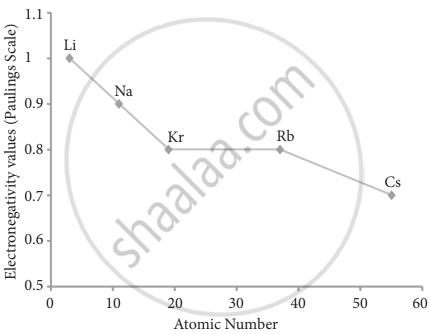Advertisements
Advertisements
Question
State the trends in the variation of electronegativity in groups and periods.
Solution
1. Variation of electronegativity in a group: The electronegativity decreases down a group. As we move down a group, the atomic radius increases, and the nuclear attractive force on the valence electron decreases. Hence electronegativity decreases in a group.

Variation of electronegativity along with I group
2. Variation of electron negativity in a period: The electronegativity increases across a period from left to right. Since the atomic radius decreases in a period, the attraction between the valence electron and the nucleus increases. Hence the tendency to attract shared pair of electrons increases. Therefore, electronegativity increases in a period.

Variation of electronegativity along with II group
APPEARS IN
RELATED QUESTIONS
Which of the following elements will have the highest electronegativity?
The electronic configuration of the atom having maximum difference in first and second ionisation energies is
IE1 and IE2 of Mg are 179 and 348 kcal mol−1 respectively. The energy required for the reaction \[\ce{Mg -> Mg^2+ + 2e^-}\] is
The First ionisation potential of Na, Mg and Si are 496, 737 and 786 kJ mol-1 respectively. The ionisation potential of Al will be closer to
How does electron affinity change when we move from left to right in a period in the periodic table?
What are isoelectronic ions? Give examples.
Magnesium loses electrons successively to form Mg+, Mg2+ and Mg3+ ions. Which step will have the highest ionisation energy and why?
In what period and group will an element with Z = 118 will be present?
Explain the following, give an appropriate reason.
Ionisation potential of N is greater than that of O
Briefly give the basis for Pauling's scale of electronegativity.
